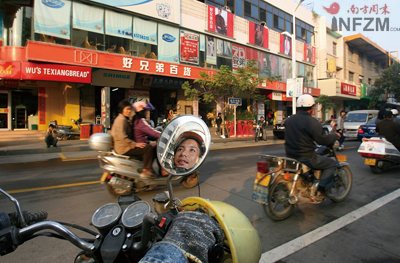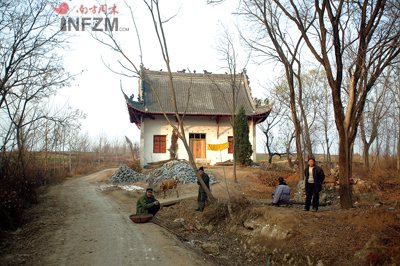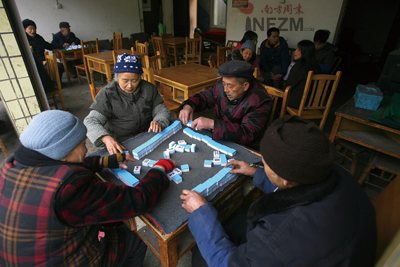Over the past decade, startling changes have unfolded in China with each passing day.
We watched these changes like insiders as the Southern Weekend's correspondents from 1998 to 2007 kept chronological records of three spots across the country: a village in central China, a town in west China and a road in east China. Chosen at random, they depict the lives, minds and changes in China.
The three spots, three ordinary places you can find throughout China, epitomize all the major changes in China during the last decade. See how China has evolved over the last three decades
Economic development
China has witnessed its fastest development ever during the last decade, as the GDP soared from 8440.23 billion in 1998 to 18386.7 billion in 2006, a 2.18 times increase.
 |
|
A time-worn street in Bailu Town
|
In 1998, a 200-meter-long road was embraced as the only road in Bailu Town in west Sichuan Province. But when visitors entered the town in 2003, an array of fancy villas along the river immediately came into view, along with a second new road that hugs the town. Within just a year, many residential buildings have sprouted up alongside the new road. In 2005, the town initiated the Longmen Mountain National Geopark project and established a better transit service with a regular shuttle bus to downtown Pengzhou. In 2006, a new highway that would offer quicker access to the provincial capital Chengdu City was already in the works. The town is now relying more on its eco-tourism.
 |
|
Shops have sprawled out into the Chenggong Road over past years.
|
Chenggong West Road in Anhai Town, Jinjiang City, a region that borders the Taiwan Straits, was previously just shy of 4 meters in width. In 1998, the town widened the road and gradually turned it into a commercial strip. In 2006, city planning accepted the goal to build Anhai Town into a hub of industry and commerce in western and central Jinjiang City. Anhai Town has emerged as a burgeoning economic force in the city with its tax revenues on the rise.
See what has happened to the road
|

|
|
A normal day in Xiaochangzhuang Village
|
Xiaochangzhuang Village is located in central China's Henan Province. In 1998 cattle and poultry roamed freely throughout the village, dropping dung everywhere. Just three years later, the area has topped out with an acre of buildings, together with an improved telecommunication system. In 2004, an industrial complex had been almost completed, livening up the adjacent highway after years of economic inertia. In fact, China's total highway miles have doubled in the past decade; it is now second only to the United States. Such a highway network that touches every corner of the country is driving the many villages like Xiaochangzhuang into modern times.
A sample survey polled among the villagers in 2005 revealed that the majority thought 2005 was better than the past year.
But unstable factors lie behind the veneer of prosperity.
Coalmines and rhizome (a bitter herb) plantations were two enablers for the local economy in Bailu Town. The coal industry provided a bonanza to the town and created many job opportunities to capitalize on surplus labor forces. But a series of coal mine closures due to pollution and hazardous circumstances left the town with lost jobs and a relatively sagging economy. In 2002, five of the 20 coalmines closed down and two years later a coalmine accident caused heavy casualties.
The surrounding mountains in the town were once natural habitats for rhizomes. A decade ago, not a few villagers made profits by planting and selling rhizomes at handsome prices. In 2000, almost all the local farmers rushed to cash in on the lucrative business when prices spiraled up and peaked at 180-200 yuan per kilogram. But the profits have become very thin since the price dipped in 2001. In the winter of 2005, the farmers began to experience an economic depression as bleak as the cold season as the herb prices dropped off and coal mine's close down.
The volatile factors that impose a direct influence on agriculture range from climate and market to government policy. A severe drought in Xiaochangzhuang in 1999 greatly reduced crop output. Chang Quanguo, an elderly villager, was even reduced to begging with his wife at that time. Before 1998, Xiaochangzhuang declared itself as prosperous, but the word existed only on paper. From 2001 to 2005 the dry and sterile soil dampened the villagers' enthusiasm toward tending their farmland. Younger villagers felt even more disappointed and less enthusiastic. In 2005, productive raw materials prices soared while agricultural products reversed direction. Although the government abolished agricultural taxes in the same year, China's small peasant economy is still floundering and can hardly carve out a foothold in today's modern markets.
Modus vivendi
A stable way of life emerges from a combination of economics, politics, culture, customs and geography. China's tidal reform wave swept through the country, drastically altering previous lifestyles. Now, in the mainland melting pot, people are simultaneously traditional and modern, open and conservative.
 |
| Elders sit in a teahouse, playing Mahjong, a popular Chinese game. |
Lounging in a teahouse is a distinct and unadulterated way of life in Sichuan. But in 1998 a bar appealed to the townspeople as a novelty and lured legions of young patrons away. Next barbershops transformed into beauty salons; they catered to remote countrywomen dropping by while traveling to rural fairs.
In 2004, the Internet-savvy Party chief of the town learned how to use the instant message tool. Two net bars opened in the same year, connecting the local youth to the outside world.
In 2000, Anhai Town was caught in a health craze, with fitness establishments sprouting up along the Chenggong Road. Two years later, a fancy and chic disco became a magnet for fashion-conscious people. There, scantily clad girls wiggled around steel tubes, arousing audience frenzy, with people waving their arms and yelling.
Xiaochangzhuang is typically quiet, especially during slack farming season when young villagers migrate to the cities seeking jobs. At noon only old men sit under trees and children play nearby.
While beauty salons, Internet cafes and discos were getting popular, the rural wedding ceremonies and funerals seemed immune to their influx, except regarding costs. Xiaochangzhuang encouraged cremation several years ago but encountered entrenched opposition due to the widespread Chinese belief that the soul will find peace only if the body rests in the ground.
For Bailu Town and Chenggong Road, the pace is far more hectic than before. The modern changes represent a fresh twist but it comes at the cost of leisure and tranquility. Idyllic village life has been gradually swallowed up by modern culture.